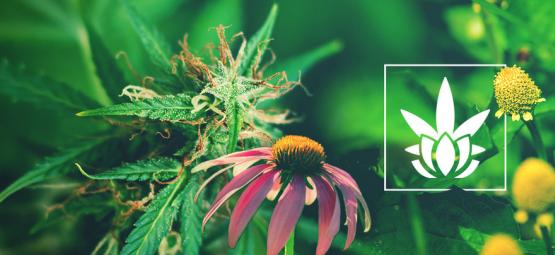Synthetic Vs Natural Cannabis: What’s The Difference?
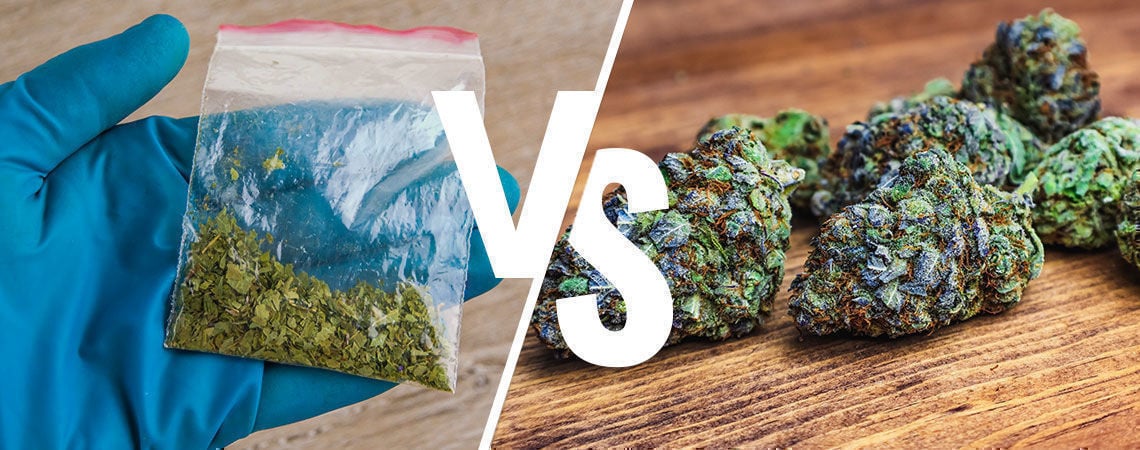
There are three kinds of cannabinoids: those produced by the body, those produced by plants, and those produced in a lab. Many of the latter, known as synthetic cannabinoids, can be extremely dangerous, and even lethal. Here's what you need to know about synthetic vs natural weed, and why the distinction matters.
There is still a great deal of misunderstanding about the differences between natural, plant-derived cannabinoids—or phytocannabinoids—and synthetic (human-made) cannabinoids. There is further confusion surrounding synthetic cannabinoids produced for specific medical purposes versus those created for illegal commercial sale.
On the legit side, there are forms of synthetic CBD and THC that are legally produced and sold as pharmaceuticals or health products. On the other side of the spectrum are illicit synthetics such as the cannabinoid K2, also known as Spice. Up to 100 times more potent than THC, it is also highly dangerous and has been known to cause a range of serious health effects, and even death (Groth, 2023).
For the average cannabis consumer, here is a simple rule of thumb: most synthetically produced cannabinoids are bad news. It is best to avoid them if you care about your health. With that in mind, let’s take a look at the differences between natural cannabis and synthetic cannabis, and see what this means for consumers.
Not all cannabis is created equal
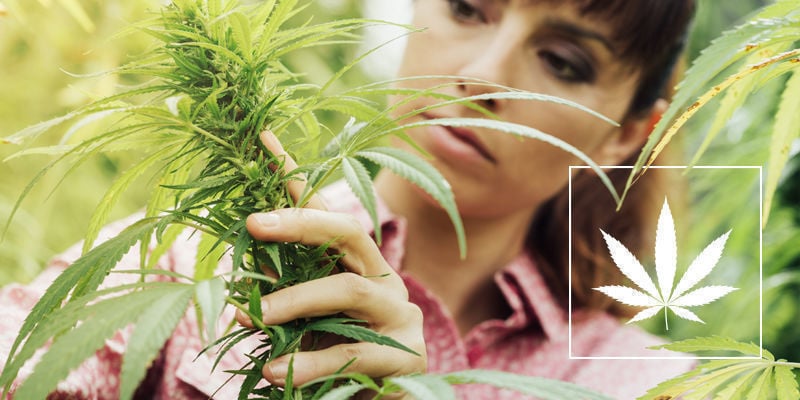
There are several ways to synthesise cannabinoids—chemical structures that bind to or impact cannabinoid receptors found in the human body.
Well over 100 naturally occurring phytocannabinoids have been identified in the cannabis plant, including CBD and THC. As legalization continues to progress globally, more and more studies are being conducted on cannabinoids, both individually and in combination.
Another way to create cannabinoids is in a lab. There are already over 300 synthetic cannabinoids in existence and this number will only increase. While some consumers are under the impression that these sometimes-legal substances are “safer” than natural cannabinoids, nothing could be further from the truth, as we will explain below.
Finally, it’s worth noting that cannabinoids are also synthesised by the human body! Endocannabinoids such as anandamide and 2-arachidonoylglycerol are produced to modulate a wide range of physiological processes via the endocannabinoid system (ECS) and its receptors.
The endocannabinoid system relies on balance
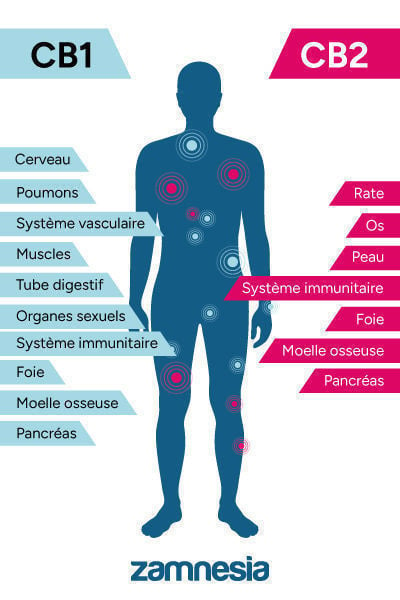
While some phytocannabinoids are capable of stimulating or influencing ECS receptors and enzymes to a greater degree than our own endocannabinoids, the nature of natural cannabis means it never goes overboard.
The two main cannabinoid receptors in the body, CB1 and CB2, are crucial to helping the human body maintain dynamic balance, also known by its scientific name homeostasis. Located throughout the brain and body, these receptors work via a lock-and-key principle. If the chemical structure of the cannabinoid matches the “lock” on the receptor, it acts like a key to make the receptor respond.
It is this mechanism that stops the body from processing excessive amounts of cannabinoids; it is also this feature that prevents lethal overdoses when using natural cannabinoids. With synthetic cannabis, however, these cannabinoids are given a general shape that allows them to “burst open” the lock and stimulate receptors to a degree that is unfavourable or even dangerous.
Natural and synthetic cannabis: the basics
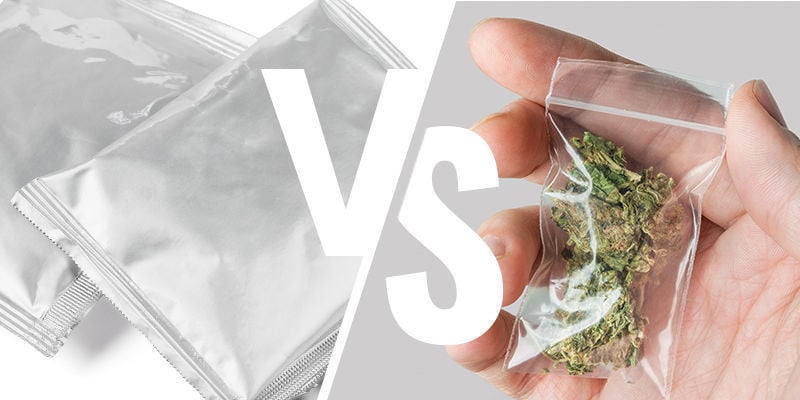
Natural and synthetic weed are quite distinct, and it’s important to know the main differences between them. Below we provide an overview of each category, followed by some examples of natural and synthetic cannabinoids.
What is natural cannabis?
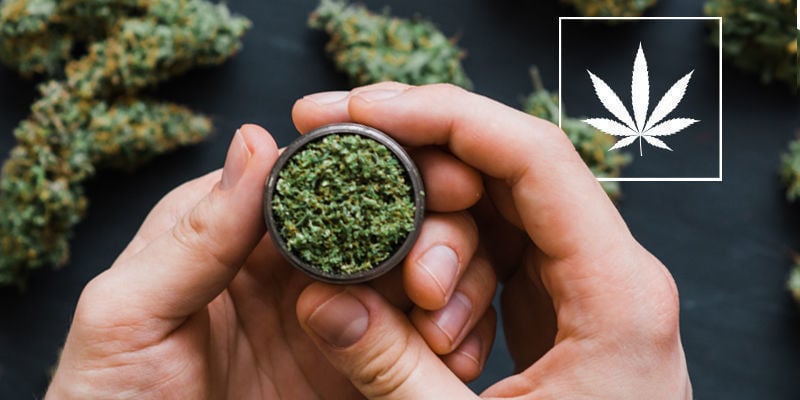
The two forms of “natural cannabis”—or more accurately, “natural cannabinoids”—are phytocannabinoids and endocannabinoids. Both endo- and phytocannabinoids are capable of affecting cannabinoid receptors and enzymes, causing a variety of effects in humans. Yet, unlike synthetic cannabinoids, natural cannabinoids will not overstimulate cannabinoid receptors to the point of being dangerous. Endocannabinoids can not be consumed, but can only exert their effects by being naturally produced in the body.
Examples of natural cannabis
Any cannabinoid extracted from the cannabis plant can be considered a natural phytocannabinoid. Some examples include:
The two main examples of natural endocannabinoids in humans are anandamide (AEA) and 2-arachidonoylglycerol (2-AG).
What is synthetic cannabis?
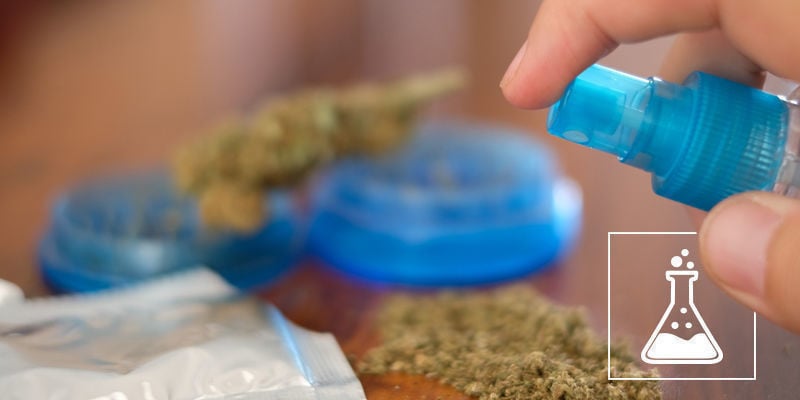
Though they are undoubtedly different, both synthetic and natural cannabinoids work by stimulating receptors of the endocannabinoid system, most notably CB1. After all, we get high by stimulating our CB1 receptor; so, if synthetic cannabinoids did not bind to CB1, we would not want to buy them as a replacement for cannabis. Indeed, synthetic cannabinoids are more accurately described as cannabinoid receptor agonists.
Rather than being created from cannabis-derived compounds, synthetic cannabinoids are made using a variety of other chemicals and processes. Some of these are more scientifically reliable than others. In the case of government-approved pharmaceuticals, the idea is to mimic the medicinal action of cannabinoids in the safest way possible, while limiting the risks of harmful effects. In order to assess the safety of these products, they are put through rigorous clinical trials. With street synthetic marijuana, the likelihood of experiencing adverse effects is much greater as they are not tested.
However, even pharmaceutical companies have found that altering cannabinoids to achieve certain effects can be dangerous. Rimbonant was a cannabinoid medicine produced to limit appetite that caused suicidal thoughts in patients, and was thus removed from the market around 2009.
Synthetics produced in a non-pharmaceutical environment, without even basic quality controls, can be even more dangerous than this, if not outright lethal.
Synthetic cannabinoids generally fall into the following categories (Presley et al., 2013):
- Cyclohexylphenols
- Naphthoylindoles
- Naphthylmethylindoles
- Naphthylmethylindenes
- Naphthoylpyrroles
- Phenylacetylindoles
- Adamantoylindoles
- Tetramethylcyclopropylindoles
Other kinds of synthetically produced cannabis receptor agonists include oleamide, which is commonly used in plastics manufacturing ("Synthetic cannabinoids and 'Spice' drug profile”).
Oleamide and methanandamide, and other synthetic cannabinoids, are structurally related to our body's own anandamide endocannabinoid.
Additionally, synthetic cannabinoids are almost always “isolates”, meaning there is only one chemical intended to stimulate the internal cannabinoid receptors of the body to the max. Sometimes, such compounds are synthesised from part of a THC molecule and then further modified in a lab. However, most forms of synthetic cannabis never come into contact with natural cannabinoids at all.
As a synthetic substance, there is really no way for you as a consumer to know what other chemicals were used to create synthetic marijuana bought on the street. These substances are often mixed with or sprayed onto natural plants and herbs to make them look like natural products.
Examples of synthetic cannabis
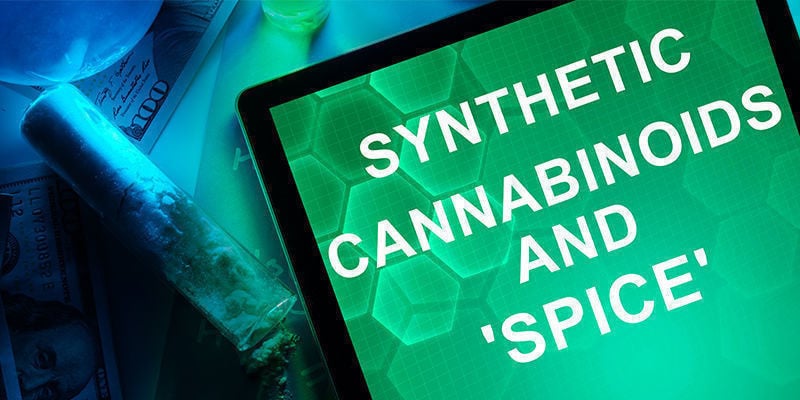
Many synthetic marijuana products are deliberately designed to avoid legal restrictions on cannabis, and are sometimes marketed as “not for human consumption”. For example, K2 was originally sold as a form of "potpourri" or "incense" not meant for human consumption. But, of course, consumers knew exactly what to do with this product once they brought it home. The synthetic cannabinoids found in such products often have a greater, and possibly overwhelming, effect on the cannabinoid receptors of the body.
Since the beginning of this century, more than 142 synthetic cannabinoids have been found by authorities in Europe. They can appear even in products such as gummy bears and vape products purporting to be natural CBD or THC.
Here are a few names and titles associated with illicit, and often dangerous, synthetic cannabinoids:
- Spice
- K2
- Yucatan Fire
- Sence
- Chill X
- Smoke
- Genie
- Algerian Blend
Note: these names can shift and change, and you should not assume you know which chemicals you are consuming based on their colloquial name.
Natural vs synthetic cannabis
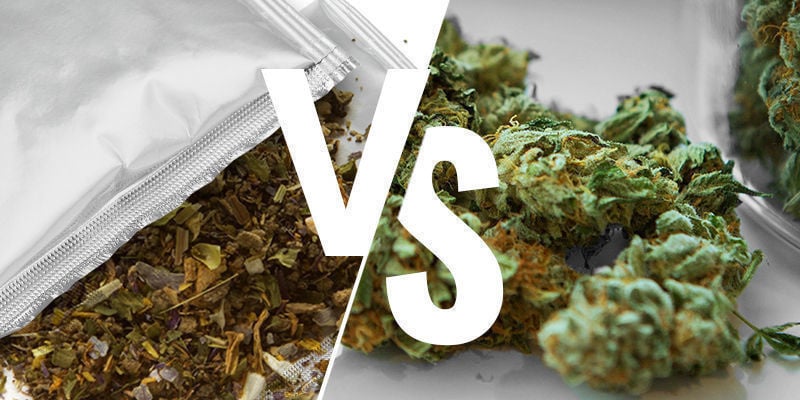
Now that we’ve reviewed the general principles of natural and synthetic cannabis, it’s time to get into a little more detail.
Chemical structure
Synthetic cannabinoids are cannabinoid receptor agonists (meaning they bind to them). However, they are not chemically identical to naturally occurring cannabinoids. Most of the synthetic ones are soluble in fats and consist of between 22 and 26 carbon atoms. Most also have what is called a “side chain”, featuring four to nine saturated carbon atoms. The optimal binding affinity for CB1 is believed to be between 5 and 8 carbon atoms, with any more actually decreasing activity ("Why does alkyl chain length matter", 2020). Little else is known about the detailed pharmacology (and toxicity) of synthetic cannabinoids, as very few formal studies have been conducted.
Natural cannabinoids, however, tend to feature 21 carbon atoms, although this is not always the case. Side chain length can also vary significantly. However, this variation in structure lies within a certain window that prevents any seriously adverse effects from occurring.
In conclusion, synthetic cannabinoids are designed on purpose to go far beyond the mild actions of the natural cannabinoids present in the plant. As a result, they may do serious harm to your endocannabinoid system, and therefore your health.
Application

Natural cannabinoids have long been used for holistic or religious purposes beyond “just” relaxation. That said, cannabinoids like THC are also used recreationally.
Synthetic cannabinoids were originally created to mimic natural cannabinoids for medical purposes, particularly in the past when marijuana was simply illegal.
The current market of synthetics was created largely by illicit producers hoping to legally market their products, even in places where cannabis is now legitimate, but with no concern for human safety or health. Most synthetic cannabinoids are made to be smoked—although it is possible to find them in edible products, such as candies. Gummy bears are a popular edible to infuse synthetics with. It is also possible to vape synthetics. But the most common method of ingestion is certainly smoking plant matter that has been infused with synthetic cannabinoids.
Some synthetic compounds have been produced in labs to mimic natural cannabinoids for therapeutic purposes. In the US, the FDA has approved the following synthetic cannabis substances, which are available only with a prescription: Marinol (dronabinol), Syndros (dronabinol), and Cesamet (nabilone) ("FDA and cannabis: Research and drug approval process", 2020). These drugs are only used in specific medical circumstances and are not widely prescribed.
Safety
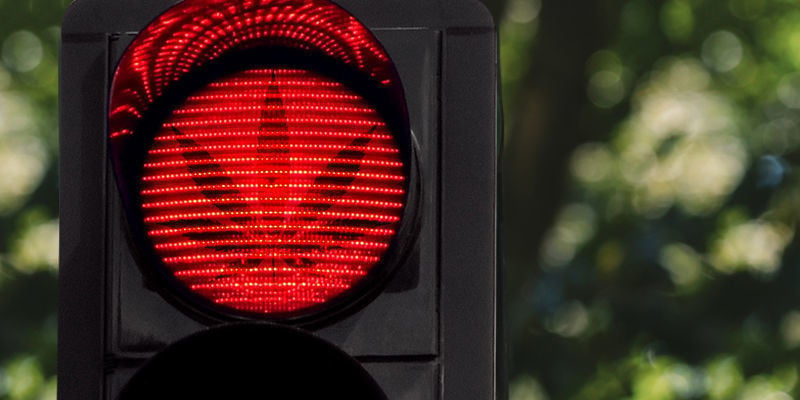
Unless the synthetic cannabinoid ingested is properly manufactured in a pharmaceutical lab that is also certified for medical use, all synthetic cannabinoids should be considered as potentially dangerous. Beyond this, many are mixed with other dangerous chemicals or drugs. In the United States, the Food and Drug Administration has even found these products to contain a rat poison called brodifacoum, which is added to supposedly “extend” the effects.
The best and safest policy is to avoid them completely. They are not regulated by any health authorities, and are usually produced solely for profit by companies that have no concern for your health.
Natural cannabis, however, presents a much less worrying safety profile, although the intoxicating nature of marijuana can still increase the risk of motor vehicle accidents and cause acute and long-term effects on one’s health.
Is synthetic cannabis really that dangerous?
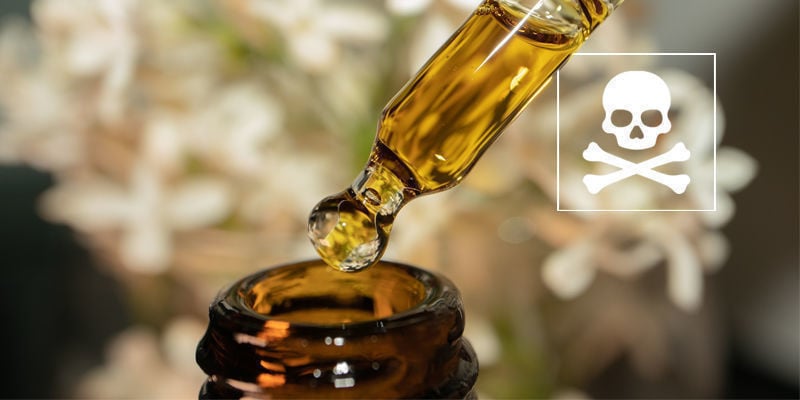
The short answer is yes. Synthetic drugs produced outside the legal system are almost always hazardous. One of the largest problems is that manufacturers deliberately market their products to look legit.
Counterfeit cannabinoids have shown up in edibles, like candy, in counterfeit hash, and, of course, in pre-manufactured vapes. It is well-known that synthetic cannabis that is used for recreational purposes can have extremely bad effects on users.
Side effects of synthetic cannabinoids

While this is not an exhaustive list, here are some of the side effects reportedly caused by synthetic cannabinoids:
- Dizziness
- Nausea and vomiting
- Paranoia
- Poor coordination
- Shortness of breath
- Seizures
- Palpitations
- Passing out
- Death from overdose
Can synthetic cannabis be beneficial?

Some synthetic cannabinoids can be used as a medical treatment to improve human health. These include legal cannabinoid drugs such as Sativex, which can be produced from either natural cannabinoids or synthetics, Epidiolex, which is made solely from CBD or synthetic equivalents, and Cesamet, also known as nabilone, which is approved to treat movement disorders like Parkinson’s.
Many patients, however, prefer to be medicated not only with naturally derived cannabinoids, but by harnessing multiple natural cannabinoids and cannabis plant constituents, rather than just isolates.
The best way to ensure that your cannabis is natural and without chemical additives is to grow it yourself. However, this can also be risky if you live in a part of the world where this practice is still illegal. Nevertheless, growing a small plant or two is arguably safer than risking your health with synthetic cannabis bought from untrustworthy subjects. Be safe out there.
- Cayman Chemical. (2020, April 13). Why does alkyl chain length matter? - https://www.caymanchem.com
- EMCDDA. (n.d.). Synthetic cannabinoids and 'Spice' drug profile - https://www.emcdda.europa.eu
- FDA. (2020, October 1). Research and drug approval process - https://www.fda.gov
- Groth, Olwen, Roider, Gabriele, Angerer, Verena, Schäper, Jan, Graw, Matthias, Musshoff, Frank, Auwärter, & Volker. (2023, July). “Spice”-related deaths in and around Munich, Germany: A retrospective look at the role of synthetic cannabinoid receptor agonists in our post-mortem cases over a seven-year period (2014–2020) - https://doi.org
- Presley BC, Jansen-Varnum SA, & Logan BK. (2013). PubMed - https://pubmed.ncbi.nlm.nih.gov
- Presley BC, Jansen-Varnum SA, & Logan BK. (2013 Mar). Presley, B.C., Jansen-Varnum, S.A., en Logan, B.K. (2013). Analysis of Synthetic Cannabinoids in Botanical Material: A Review of Analytical Methods and Findings. Forensic science review, 25 1-2, 27-46 - https://pubmed.ncbi.nlm.nih.gov
- World Health Organization. (n.d.). Cannabis - https://www.who.int
You might also like














 United States
United States




